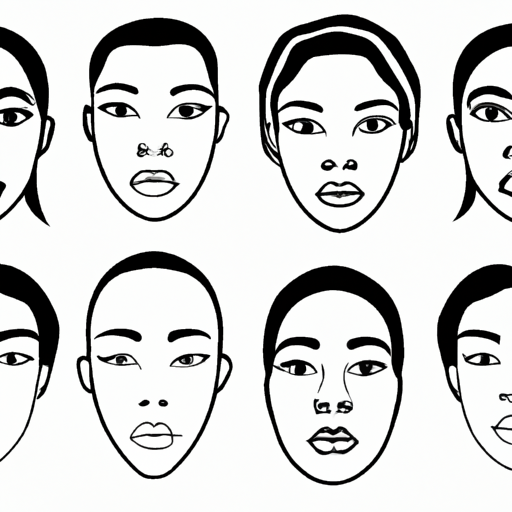- Your cart is empty
- Continue Shopping
Decoding the Enigma: Exploring the Different Types of Facial Skin and How to Care for Them

Our faces are unique, just like our fingerprints. From dry and sensitive to oily and acne-prone, our facial skin comes in a variety of types, each requiring its own specific care and attention. Understanding the diversity of facial skin is crucial in order to effectively diagnose and identify different skin types. In this article, we will delve into the world of facial skin, exploring the various symptoms, causes, and treatment options that are specific to each type. Whether you have dry, oily, combination, sensitive, or normal skin, this article will provide valuable insights on how to properly care for your skin and achieve a healthy, radiant complexion. Join us as we unlock the secrets of facial skin and explore personalized treatment approaches for every skin type.
1. Understanding the Diversity of Facial Skin: Diagnosing and Identifying Different Skin Types
Understanding the Diversity of Facial Skin: Diagnosing and Identifying Different Skin Types
The human skin is a complex organ that comes in various types, each with its own characteristics and requirements. Understanding the different types of facial skin is crucial for diagnosing and treating various skin conditions effectively. By becoming familiar with the symptoms, causes, and unique needs of each skin type, individuals can develop personalized skincare routines that cater to their specific concerns.
One of the most common skin types is normal skin, which is neither too oily nor too dry. It appears smooth, balanced, and has a healthy complexion. Normal skin rarely experiences breakouts or sensitivity, making it relatively easy to maintain. However, even normal skin requires regular care to prevent aging and maintain its natural radiance.
On the other end of the spectrum, there is oily skin. This type of skin produces excess sebum, resulting in a shiny appearance, enlarged pores, and a predisposition to acne. Individuals with oily skin often struggle with frequent breakouts and may find it challenging to keep their skin clean and clear. The causes of oily skin can vary, including genetics, hormonal changes, and environmental factors. Managing oily skin often involves cleansing thoroughly, using oil-free products, and incorporating ingredients like salicylic acid or benzoyl peroxide to control oil production and treat acne.
Dry skin is another common skin type characterized by a lack of moisture and a dull, flaky appearance. It can feel tight, itchy, and uncomfortable. Dry skin may be a result of genetics, aging, or environmental factors such as harsh weather conditions or excessive exposure to hot water. Individuals with dry skin need to focus on hydrating and nourishing their skin. This can be achieved through regular moisturization, avoiding harsh cleansers, and incorporating products containing hyaluronic acid or ceramides to help retain moisture.
Combination skin is perhaps the most challenging to diagnose and treat. It is characterized by having both oily and dry areas on the face. Typically, the T-zone (forehead, nose, and
2. Unlocking the Secrets of Facial Skin: Common Symptoms, Causes, and Treatment Options
Facial skin is unique and varies greatly from person to person. Understanding the different types of facial skin and their associated symptoms, causes, and treatment options can help individuals better care for their skin and address any concerns they may have.
One common skin type is oily skin. People with oily skin often experience excessive shine, enlarged pores, and a tendency for acne breakouts. The overproduction of sebum, the skin’s natural oil, is the primary cause of oily skin. Hormonal imbalances, genetics, and certain medications can contribute to this condition. To manage oily skin, individuals should cleanse their face twice daily with a gentle cleanser and use non-comedogenic products. Regular exfoliation and the use of oil-free moisturizers can also help control oil production.
Dry skin is another prevalent skin type. It is characterized by a lack of moisture, resulting in tightness, flakiness, and sometimes even itchiness. Cold weather, harsh cleansers, and certain medical conditions can cause dry skin. To alleviate dryness, individuals should use gentle, hydrating cleansers and moisturizers that contain ingredients like hyaluronic acid and ceramides. Additionally, incorporating a humidifier into their living environment can help maintain moisture levels in the air.
Combination skin is a blend of oily and dry skin, with some areas being oilier than others. Typically, the T-zone (forehead, nose, and chin) exhibits oiliness, while the cheeks and other parts of the face remain dry. Combination skin can be challenging to manage as it requires a balance between controlling excessive oil production and providing adequate hydration. Individuals with combination skin should use oil-free or lightweight moisturizers, avoid harsh cleansers, and consider using oil-absorbing products on oily areas.
Sensitive skin is prone to irritation, redness, and allergic reactions. It reacts easily to environmental factors, such as sun exposure, weather changes, and certain skincare products. People with sensitive skin often experience discomfort and may develop rashes or hives. The causes of sensitive skin can
3. Tailored Care for Every Skin Type: Exploring Personalized Treatment Approaches for Different Facial Skin Types
When it comes to facial skin, one size definitely does not fit all. Each individual is unique, and so is their skin. Understanding and acknowledging the distinct characteristics of various skin types is crucial in providing effective and personalized treatment approaches. Tailored care can make a significant difference in achieving optimal skin health and addressing specific concerns.
There are generally five main skin types: normal, dry, oily, combination, and sensitive. While some individuals may fall into one specific category, others may have a combination of characteristics. To provide the most suitable treatment for each skin type, it is essential to diagnose and understand the symptoms, causes, and specific needs of each individual.
Normal skin is considered the ideal skin type, with balanced moisture levels and a healthy complexion. It is generally free from major concerns such as excessive dryness or oiliness. However, even individuals with normal skin can benefit from personalized care to maintain their skin’s health and prevent potential issues.
Dry skin is characterized by a lack of moisture, resulting in a dull, flaky, and sometimes itchy complexion. This skin type often requires extra nourishment and hydration to restore and maintain its natural moisture barrier. Treatment approaches may include the use of gentle cleansers, rich moisturizers, and hydrating masks to replenish lost moisture and promote a healthy skin barrier function.
On the other end of the spectrum, oily skin is marked by excessive sebum production, leading to a shiny and often acne-prone complexion. Managing oil production and preventing breakouts are key goals for this skin type. Treatment approaches may involve oil-free cleansers, lightweight moisturizers, and oil-controlling products to minimize shine and keep pores clear.
Combination skin is a combination of dry and oily areas, often with an oily T-zone (forehead, nose, and chin) and dry or normal cheeks. Treating combination skin requires a delicate balance to address both dryness and oiliness. Tailored care may involve using different products on different areas of the face, such as oil-absorbing products on the T-zone and hydrating

